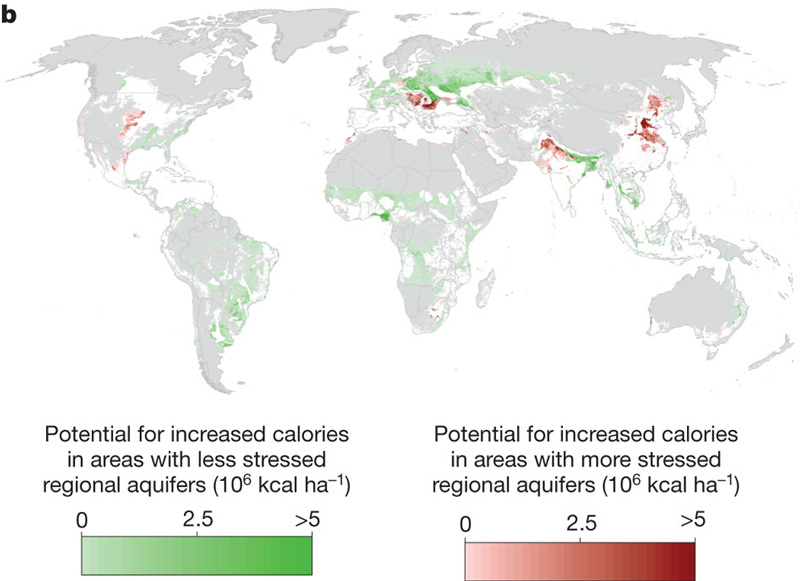-
Stress Levels of Major Global Aquifers Revealed by Groundwater Footprint Study
August 21, 2012 By Carolyn LamereIn the “first spatially explicit comparison of groundwater use, availability, and environmental flow for aquifers globally,” a new article in Nature finds that the “size of the global groundwater footprint is currently about 3.5 times the actual area of aquifers.” An aquifer’s footprint is the theoretical size it would need to be to sustainably support use at its current rate, so groundwater footprints being much larger than their corresponding aquifers is a sign of overuse.
Authors Tom Gleeson, Yoshihide Wada, Marc F. P. Bierkens, and Ludovicus P. H. van Beek used the Global Groundwater Information System and a recharge model to calculate the global rate of water use compared to water available in aquifers. They particularly highlight overuse in six major aquifers: the Western Mexico, High Plains, North Arabian, Persian, Upper Ganges, and North China Plain.
Some aquifers are replenishable, like many in India, for example, but are being refilled more slowly than they are being drained. Others – called “fossil aquifers” – are not, like the Ogallala aquifer in the midwestern United States and the Sana’a Basin in Yemen. Geological changes mean that streams streams which once deposited water no longer reach them. Once water is depleted from the fossil aquifers, farmers must turn to other forms of irrigation or cease agricultural production altogether. Even before aquifers run dry, falling water tables increase the cost of irrigation by forcing farmers to drill deeper and deeper for access to water.
Yemen, for example, has both rechargeable and fossil aquifers, but population growth and poor management has meant that it is using up water more quickly than it can be replenished. Wells in the capital now reach between 2,600 and 3,200 feet below the surface to hit the water table and some experts predict the country will run out of water by 2025 – the first in the modern era.
Gleeson et al. also mapped the population density of the six “stressed regional aquifers.” The Upper Ganges and the North China plain are two hotspot areas where population is particularly dense and aquifers are already strained. The Upper Ganges is especially worrisome because it includes already dense areas with growing populations, like Pakistan, which has a total fertility rate (TFR) of 3.6 children per woman, and the Indian province of Uttar Pradesh, with a TFR of 3.8.
However, despite the grim state of the major aquifers highlighted, over-use is not universal. There are many that appear to be being used at sustainable rates, noted in Figure 1 in blue. Indeed, some regions thought to be water scarce actually have enormous underground reserves, like those recently mapped in Africa. Some unfortunately have little prospects to enhance agriculture though. For example, northern Russia has ample water resources, but Siberian winters are a natural limit to agricultural production.
One way to increase food production is to make already-existing farms more efficient. The article takes a look at how “bringing the world’s agricultural yields to within 95 percent of their potential” would impact the groundwater of each region. The authors also illustrate the agricultural capacity of each region. This is a key measurement, as some experts predict food supplies will need to increase at least 70 percent by 2050 to meet the needs of an expanding and higher-consuming world population.
Unfortunately, many of the areas which have the most room to improve in capacity are already over-consuming groundwater, like the American Midwest, the Upper Ganges, the North China plain, and parts of Poland and Ukraine. These areas are the traditional global grain producers, but because of already-existing stress on their aquifers, “groundwater cannot be used sustainably to increase [their] yields.” This creates the possibility of a water-agriculture chokepoint developing in many existing breadbaskets.
Overall, the article and maps offer a much more complete picture than we’ve had before of the world’s aquifers. “Practically,” the authors write, “[the study] allows short-term water resource monitoring and management measures to focus on the handful of aquifers with egregious groundwater footprints rather than dissipating efforts across all aquifers. Additionally, the groundwater footprint can be used to assess the potential to achieve increased agricultural yields with sustainable groundwater.”
Sources: Food and Agriculture Organization, Nature, Reuters, UN Population Division.
Maps Credit: Used with permission courtesy of Nature.
Topics: Africa, agriculture, China, consumption, environment, Europe, Eye On, featured, India, Pakistan, population, Russia, U.S., water, Yemen
 A Publication of the Stimson Center.
A Publication of the Stimson Center.






